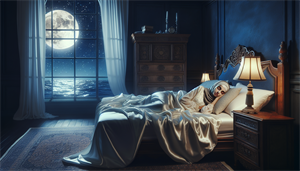Have you ever wondered why we breathe through our noses? Or why mouth breathing can be harmful? Nasal breathing is a vital, yet often overlooked, aspect of our health. When disrupted, it can lead to a range of health issues.
In this blog post, we delve deep into the causes and effects of mouth breathing, how to identify it, and the importance of nasal breathing. We also explore useful strategies, professional treatments, and lifestyle changes that can help in fixing mouth breathing and address this issue.
Key Takeaways
-
Mouth breathing is caused by an inability to breathe adequately through the nose due to factors like incorrect tongue function and misshapen mouth and jaws, leading to various health issues such as sleep apnea, developmental problems in children, and exacerbated existing health conditions.
-
Identifying mouth breathing symptoms such as snoring, concentration difficulties, morning headaches, and bad breath is crucial for early intervention and treatment, which might sometimes require consulting a healthcare provider.
-
Several strategies, ranging from home remedies to professional treatments like myofunctional therapy and orthodontics, can assist in correcting mouth breathing, alongside lifestyle changes to alleviate stress and promote better sleep hygiene.
Understanding Mouth Breathing: Causes and Effects

To address mouth breathing, one must first comprehend it. Mouth breathing is mainly attributed to the inability to receive adequate oxygen through the nose, often stemming from incorrect tongue function and suboptimal size and shape of the mouth and jaws. This problem becomes more pronounced at night when nasal breathing becomes challenging, causing individuals to resort to mouth breathing to ensure adequate oxygen intake.
Mouth breathing has significant, wide-ranging implications. It can lead to:
-
Increased risk of sleep apnea
-
Elevated heart rate and blood pressure
-
Reduced oxygen levels during sleep
-
Disrupted sleep patterns
-
Developmental issues in children, such as facial underdevelopment, misaligned teeth, and impaired growth
-
Gum disease and bad breath in adults
-
Exacerbation of existing health conditions
Early diagnosis and intervention of mouth breathing is crucial. The next section will guide you on how to diagnose mouth breathing by identifying its signs.
Identifying Signs of Mouth Breathing

Promptly addressing mouth breathing requires recognizing its signs. In mouth breathing children, these signs can include snoring at night, difficulties concentrating at school, morning headaches, lack of focus, or a resurgence of bedwetting. For adults, mouth breathing symptoms like bad breath, dry mouth, sore throat, and more severe conditions like sleep apnea and tooth decay could be indicative.
Diagnosing mouth breathing can be challenging, particularly for identifying nighttime occurrences. Consulting a healthcare provider is advisable if a child exhibits mouth breathing along with:
-
snoring
-
morning headaches
-
difficulty concentrating
-
bedwetting
A healthcare provider can aid in the diagnosis and help you navigate the next steps.
The Importance of Nasal Breathing

Recognizing the problems caused by mouth breathing requires an understanding of the importance of nasal breathing. Nasal breathing, which involves inhaling and exhaling through the nostrils, provides numerous health benefits. It:
-
Filters out bacteria, viruses and foreign particles
-
Warms and humidifies the air
-
Promotes better sleep, posture, and overall well-being
-
Enhances arousal threshold
-
Potentially increases energy levels
-
Alleviates anxiety
-
Decreases snoring
However, certain factors can impede nasal breathing, such as lying down, which can constrict nasal passages, and stress and anxiety, which may prompt mouth breathing at night.
The following subsection focuses on nitric oxide, a vital component of nasal breathing.
The Role of Nitric Oxide
During nasal breathing, nitric oxide is generated and plays a pivotal role in maintaining healthy blood pressure, immune functions, and overall well-being. The process involves oscillating airflow produced by humming, which enhances sinus ventilation and increases nasal nitric oxide levels.
Nitric oxide plays a role in maintaining healthy blood pressure by facilitating blood flow, causing blood vessels to relax, and lowering systolic and diastolic blood pressure. It also regulates immune responses, such as combating infectious organisms and controlling immune cell function.
Additionally, it facilitates blood flow, aids in nerve cell communication, potentially enhances immunity, and induces relaxation in blood vessels, thereby contributing to heart health, reducing blood pressure, addressing erectile dysfunction, and combating chronic fatigue.
Strategies to Fix Mouth Breathing

After understanding the causes and effects of mouth breathing, it’s time to delve into some corrective strategies. These range from addressing nasal congestion and altering sleep position to practicing breathing exercises. Each of these strategies will be discussed in detail in the following subsections.
Dealing with Nasal Congestion
Nasal congestion, one of the main causes of mouth breathing, can be caused by various factors, including pregnancy, certain medications, and seasonal allergies. Adopting strategies that clear nasal congestion and enhance airflow is important.
Home remedies such as blowing the nose, using a nasal wash, humidifiers, hot showers, and saline nasal sprays can help alleviate nasal blockage. Nasal strips are another effective method. They widen the nostrils and assist in the expansion of the nasal passages, promoting better airflow. However, research outcomes regarding their effectiveness vary.
Improving Sleep Position
Adjusting sleep position is another effective way to stop mouth breathing. Sleeping upright or on the side can open airways for some individuals with obstructive sleep apnea, potentially reducing mouth breathing. Special pillows like the LacunaSOLO Pillow cater to the needs of side sleepers by minimizing mouth breathing and encouraging nasal-only breathing.
Utilizing body pillows can improve the comfort of side sleeping, potentially alleviating mouth breathing caused by discomfort in this position. Furthermore, using a firm pillow for support can help prevent rolling onto the back, promoting a side sleeping position and potentially reducing mouth breathing.
Elevating the head during sleep can also reduce mouth breathing by preventing the collapse of airway tissues that may occur due to gravity when lying flat.
Practicing Breathing Exercises
Breathing exercises are significantly helpful in breaking the mouth breathing habit and fostering nasal breathing. Breathing re-education (BRE) includes a series of exercises designed to:
-
Restore nasal breathing
-
Enhance diaphragm function
-
Regulate respiratory rate
-
Enhance tolerance to variations in arterial carbon dioxide (CO2) pressure.
An example of a BRE exercise is taking deep breaths through the nose throughout the day, which helps acclimate to nasal breathing and improve nasal passage function. It is recommended to practice breathing exercises at least two to three times a day to achieve effective results.
Professional Treatments for Mouth Breathing

Although lifestyle changes and exercises can be beneficial, professional treatments may be required in some instances of chronic mouth breathing. These treatments range from myofunctional therapy and orthodontic intervention to surgical options.
The following subsections provide a detailed examination of these treatments.
Myofunctional Therapy
Myofunctional therapy, a treatment that retrains facial muscles and enhances tongue posture, encourages nasal breathing. The therapy operates by engaging in exercises that specifically target the muscles in the mouth and face, aiming to fortify them. This fortification enhances their functionality and promotes the adoption of more effective breathing patterns, particularly through the nasal passages.
Specific exercises in myofunctional therapy encompass:
-
Promoting proper jaw alignment
-
Strengthening the muscles involved in swallowing and breathing
-
Tongue-strengthening exercises
-
Techniques to improve lip seal
Results from myofunctional therapy are typically noticeable after approximately six months, and the therapy programs usually span over a period of eight to ten months.
Orthodontic Intervention
Another treatment strategy to treat mouth breathing is orthodontic intervention, which can also benefit mouth breathers. It involves the use of devices like the Schwarz expander, which expands the palate to a larger, more natural shape, creating more space for the tongue and enhancing airflow. Additionally, mouth taping can be considered as an alternative approach to address this issue.
However, not all expanders will address nasal resistance and airway problems, emphasizing the crucial need for an expert assessment to ensure the effectiveness of the treatment. Invisalign is another orthodontic treatment used to:
-
create additional space for the tongue
-
prevent it from descending into the throat and obstructing the airway during deep sleep
-
ultimately enhance airflow and address mouth breathing issues.
Surgical Options
Surgical options may be necessary for severe cases of mouth breathing or when other treatments fail to provide relief. These include:
-
Surgical jaw expansion
-
Orthodontic treatments
-
Jaw closure straps and appliances
-
Adenoidectomy
-
Septoplasty
-
Uvulopalatopharyngoplasty (UPPP)
However, surgery comes with potential risks, including:
-
sleep disorders
-
chronic sinus infections
-
sleep apnea
-
heart problems
-
recurrent ear infections
-
growth and development problems
-
migraines
Hence, it’s crucial to discuss the benefits and risks of surgery with a healthcare provider and consider it as a final resort.
Lifestyle Changes to Support Nasal Breathing
Beyond the previously discussed strategies and treatments, specific lifestyle changes can also foster nasal breathing. Stress and anxiety can trigger mouth breathing by activating the sympathetic nervous system, which can lead to rushed breathing patterns that bypass the nasal passageway.
Thus, embracing stress management techniques like yoga, meditation, and regular exercise can mitigate anxiety and encourage nasal breathing. Also, ensuring adequate rest and good sleep hygiene can prevent the triggering of mouth breathing due to disturbed sleep patterns associated with stress and anxiety.
Monitoring Progress and Adjusting Strategies
Continual progress monitoring and strategy adjustments are vital in overcoming mouth breathing. Techniques such as alternate nostril breathing, belly breathing, and Breath of Fire can be used to monitor progress in transitioning from mouth to nasal breathing. These techniques should be practiced regularly, at least two to three times a day.
Signs that adjustments are necessary include:
-
Sleep apnea
-
Sleeping with the mouth open
-
Snoring
-
Dry mouth and throat
-
Bad breath
-
Daytime fatigue
If these signs persist, it may be necessary to modify the techniques or consult with a healthcare provider. Patience and persistence are key, as transitioning from mouth to nasal breathing may take time.
Summary
As we have seen, mouth breathing is a complex issue with various causes and effects. It affects adults and children alike, leading to various health issues if left unaddressed. Fortunately, there are numerous strategies available to help overcome mouth breathing. These range from lifestyle changes and breathing exercises to professional treatments like myofunctional therapy and orthodontic intervention.
It’s important to recognize the signs of mouth breathing early and take steps to address it. With patience, persistence, and the right strategies, mouth breathing can be overcome, leading to improved health, better sleep, and a higher quality of life. Remember, the journey to overcome mouth breathing is a marathon, not a sprint. With each step, you’re making progress towards better health and well-being.
Frequently Asked Questions
Is there a cure for mouth breathing?
Yes, treatment options for mouth breathing include breathing retraining, addressing nasal blockages due to allergies or infections, and surgery to remove physical obstructions like a deviated septum or enlarged adenoids or tonsils. Combining these approaches can help manage and improve mouth breathing.
Can you reverse jaw from mouth breathing?
Yes, significant improvements can be achieved through personalized treatments and interventions, although completely reversing the effects may not be possible in adults.
When is it too late to fix mouth breathing?
It's never too late to fix mouth breathing through myofunctional therapy, as long as the practice of breathing through the nose, keeping the tongue on the roof of the mouth, and the lips together is maintained.
What are the main causes of mouth breathing?
The main causes of mouth breathing are the inability to receive adequate oxygen through the nose, often due to incorrect tongue function and suboptimal size and shape of the mouth and jaws. This can lead to a range of health issues.
What are the signs of mouth breathing in children?
If your child is experiencing snoring at night, difficulties concentrating at school, morning headaches, lack of focus, or a resurgence of bedwetting, these could be signs of mouth breathing. It's important to consult a healthcare professional for further evaluation.


